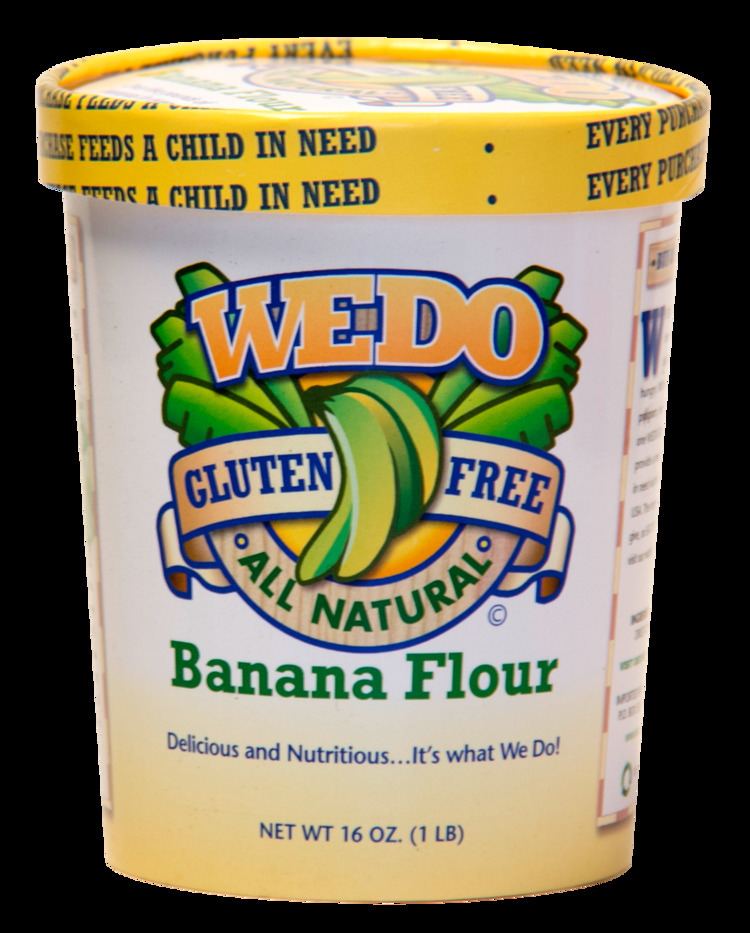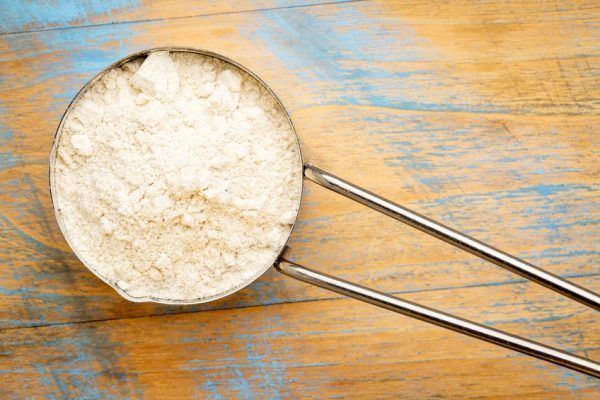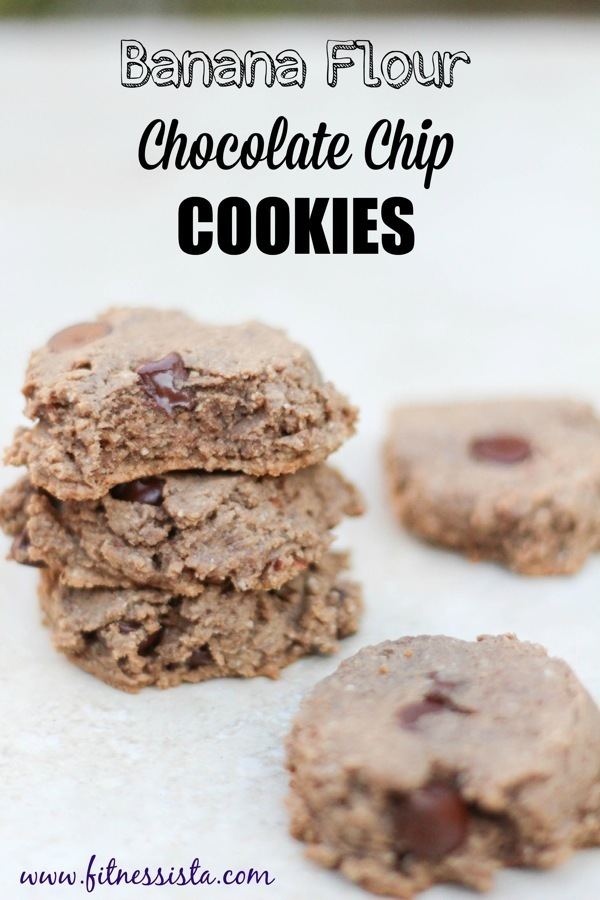 | ||
Similar Resistant starch, Banana powder, Banana wine, Matoke, Cooking banana | ||
Green banana flour
Banana flour is a powder traditionally made of green bananas that is often used as a gluten free replacement to wheat flours or as a source of resistant starch, which has been promoted by certain dieting trends such as paleo and primal diets and by some recent nutritional research. Banana flour, due to the use of green bananas, is noted for its very mild banana flavor raw and, when cooked, it has an earthy non-banana flavor; it also has a texture reminiscent of lighter wheat flours and requires about 25% less volume, making it a good replacement for white and white whole wheat flour. This has led to rising popularity among those suffering from celiac disease and gluten free dieters. Historically, banana flour has been used in Africa and Jamaica as a cheaper alternative to wheat flour.
Contents
- Green banana flour
- Banana flour process
- Production methods
- Uses
- Health benefits
- Availability
- Environmental and economic benefits
- Production concerns
- References
Banana flour process
Production methods

Banana flour is generally produced with green bananas that are peeled, chopped, dried, and then ground. This process can be completed traditionally by hand where the bananas are sun dried, dried in an oven, or a residential food dryer and then either ground in a mortar and pestle or with a mechanical grinder. The green banana process requires 8–10 kg of raw green bananas to produce 1 kg of banana flour. In recent years, large scale commercial production has begun in Africa and South America using the same basic methodology.

Chile has been developing an alternative method of banana flour production using ripe banana waste. Chilean researchers have developed a process that uses over ripe banana peels to add dietary fiber to the ripe banana fruit, which does not have the resistant starch properties of green bananas. While lacking resistant starch, there are clear advantages over banana powder. Banana powder is made from dried and ground fully ripened banana puree and thus does not have the fiber of banana peel flour content nor the resistant starch of green banana flour. Banana powder is typically used as an additive for baby food and smoothies for the large amounts of potassium and other nutrients contained in bananas without the starchy properties of green banana flour.
Uses
Historical use

Traditionally, banana flour was produced as an alternative to high priced wheat flour in various parts of Africa and Jamaica. As early as 1900, banana flour was sold in Central America under the brand-name Musarina and marketed as beneficial for those with stomach problems and pains. During World War I, the U.S. Department of Agriculture considered plans to produce banana flour as a substitute for wheat and rye flour.
Gluten free alternative

Banana flour has been imported or produced by American and Australian firms, WEDO Gluten Free and Mt. Uncle’s and Go Go Bananas which is an Indian start-up. They market them as a gluten free alternative to wheat based flours for those suffering from celiac disease and those who choose a gluten free diet. Ugandan public authorities have also marketed banana flour as a gluten free alternative and have plans for global exportation. Banana flour, in this capacity, is used not only as a replacement for wheat flour in baking, but also as a thickener for sauces and soups and as a breading for meats and vegetables.
Resistant starch

Banana flour (green variety) has gained the attention of nutritional researchers and dieters as an excellent and useful source of resistant starch (other sources include potato starch). Preliminary research has shown that increased resistant starch intake may reduce risk of obesity, diabetes, and colon cancer. Resistant starch refers to a type of starch that the human stomach cannot easily digest and thus acts similarly to soluble and insoluble fiber, in that resistant starch eases the passage of food through the digestive system like insoluble fiber while also be slowly digestible like soluble fiber. Banana flour has a high resistant starch content (17.5%) combined with excellent cooking/baking characteristics that allow it to act as a replacement for wheat flour. For this purpose, banana flour is often used raw, for example as an ingredient in smoothies, because cooking reduces the resistant starch content. However, even in cooked products like pasta, the addition of banana flour increased total resistant starch content in appreciable amounts.
Animal feed and glue manufacturing
Banana flour is used as animal feed in various parts of the world. In particular, it is used as an ingredient in milk replacers for calves. Dynasty Banana Flour Manufacturing & Trading in the Philippines and Taj Agro Products in India export banana flour worldwide for use in livestock feeds (where it acts as a coagulant) and for use in glue production, mainly plywood glue.
Health benefits
Academic and institutional researchers in a number of countries have been conducting studies on the effects of banana flour on human health. There has been such strong interest in banana flour recently, because of its high resistant starch content. One study by Thai researchers found that green bananas have the largest percentage of resistant starch, along with legumes and glass noodle products, out of numerous possible sources tested. In March 2014, Iowa State University held an international symposium on the health benefits of resistant starch. Researchers from around the world came together to discuss their various research, including that resistant starch reduces that risk of colon cancer, obesity, and diabetes. It is these benefits that have had many medical professionals suggest that the resistant starch content of current food products should be increased in order to combat these rising societal problems.
In particular, Maribel Ovando-Martinez led a group of researchers from Mexico and Spain did a study in order to find what effect the addition of banana flour to pasta would have on pasta’s resistant starch content. Their results showed that such an addition to a normal pasta recipe, even with cooking loss, appreciably increased the resistant starch content of the pasta. Other researchers did similar tests adding banana flour to bread and also found banana flour increased the total resistant starch content of the final product. Researchers have also conducted tests on the effects banana flour has on taste and general palatability. A pair of researchers found that adding 30% banana flour to yellow noodle recipes significantly increased the resistant starch content with almost no sensory/palatability difference from the control group.
In sum, banana flour’s combination of good nutritional content, high resistant starch content, and excellent palatability gives it potential as a food additive in order to reduce societal rates of obesity, diabetes, and colon cancer. In some sense, researchers are suggesting adding resistant starches, like banana flour, to most food products in order to combat wide spread health issues much like many societies have added fluoride to drinking water in order to increase dental health.
Availability
Banana flour is widely available in Africa and South America, both from traditional production and commercial production, but importation of commercial products into developed countries is limited so far. However, some cooks and health food followers in Europe and America self-produce banana flour following traditional techniques. Uganda, as one of the world’s leading producers and consumers of bananas, has plans to start the worldwide export of banana flour to Europe, Japan, and North America so it is likely that availability in Western and Asian countries will grow rapidly in the next few years.
Environmental and economic benefits
Banana flour production has been offered as a solution to high rates of waste among banana crops by both researchers and officials of various countries. Many unripe green bananas are culled and thrown out as unsuitable for sale or export. These culled green bananas are still suitable for banana flour production and, if used for this purpose, would significantly reduce waste in banana production. Thus banana producers will be able to secure greater profits from their crops, the environmental impact of those crops would be reduced, and world food production would be increased as a once wasted food stuff would now be utilized. Chilean officials have started production of an overripe banana flour made from overripe banana peels and the overripe banana fruit. This reduces waste by utilizing bananas typically thrown out when unsold or accidentally over ripened, which can occur to as much as 20% of bananas brought to market. In these ways, banana flour can reduce waste on both ends of banana crop production.
Production concerns
Banana production has long been associated with the exploitation of impoverished workers in third world countries. Banana flour production is naturally and closely connected with these concerns as some consumers worry about where the bananas going into their flour are sourced. However, many major banana producers have recently agreed to fair trade business practices, which have been shown to increase worker welfare.
